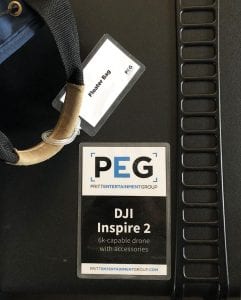Staying Organized - From Files to Gear
On any given day editors at PEG may need to sort through thousands of video and image files to complete whatever project they are working on. Our gear closet is always growing as well, so how do we make it easier for our editors and shoot crew to find the things they are looking for? We stay really organized. I will split this into a gear side and a file structure side to explain both.
Keeping Files Organized
When I first started at PEG, we had just implemented a templated folder structure that would work for each project we take on. Prior to that I think it was just a folder that said “Client Name” or something of the like, and that folder was just FILLED with random things. You live and you learn. The new template has been in place now for over 4 years and has only gone through minor changes. It has folders for every piece of a project, and makes sure everything has a place to be.
I won’t break down the full folder structure, but I do think it is important to emphasize the uniformity of it all. If your profession requires that you handle many files that come together for an awesome end product, you should be keeping it all organized! What if your client comes back to you a year from now and you aren’t able to remember where anything is because you never created a uniform system.

As early as you can in your professional career you should adapt to a consistent organization across not only your projects for clients, but even your personal file structure. Knowing where things are saves small amounts of time, but it all adds up. An example of a good structure for client projects is to have a master folder for the client, and inside of that have a folder for each specific project you are working on or have completed for the client.
Then in the most organized way possible, each project folder would contain everything you would ever need for the project, except maybe the footage, which in our case is stored on a separate network drive built for speed. But if you are editing entirely locally and have no need for a network drive to host all of your footage you can even include that in the structure as well. In the end, find a system you are proficient at navigating and that causes you no headaches!
Keeping Gear Organized
Jumping back again to when I first started here, one of my first big projects was creating gear tags for every bag and case PEG owned. The purpose of the tags was to let any of our employees know exactly what lived in each bag. Prior to this freelancers and people new to the company had a really hard time helping us tear down our bigger video shoot setups because they didn’t know where to put anything. Since then, we haven’t changed from the gear tagging system, but we are still trying to find better solutions for newer employees to really know what goes in each case without having to memorize it.

One larger change in the last 4 years has been our conversion to Pelican cases instead of PortaBrace bags. This has given us the opportunity to create adhesive labels for each and every case, and to really increase the size of the text so that you can tell right away what is meant to be in each one. We have gotten much better at creating custom foam inlays for the cases, with cutouts for all of the major components of the gear that lives there. This helps a person (who might not know where something goes inside of the case) open the case and look for the right sized cutout for what they are trying to put away. It still isn’t perfect, I think one way to improve on this further is to laminate pictures of the case in its loaded state and keep them handy. But anyway, enough on the cases!
There is another side of gear organization, and that is where all of these cases and bags live. When we moved into our new office next to the Diamond Deli in Akron, we installed 7 really sturdy shelving units and labeled each position on a shelf for a specific piece of gear. It goes without saying, but everything should have a place that it always lives. This way you know exactly where to go to get it, and there isn’t time wasted looking through stacks and stacks of cases. Across the board our gear closet is labeled twice for every piece of gear, once on the shelving and at least once on the pelican case. We did things this way so that if someone had to go get us something from the office in an emergency, they should never struggle to find it!
In summation, we take organization very seriously at PEG. And for as much thought as we have put into it, we are always putting more thought into ways to improve it. So take the time to really think on a uniform organization strategy for your team – or even just for yourself. It pays off!




